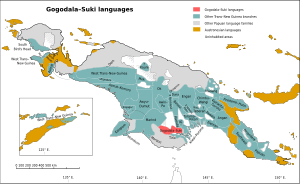| Gogodala–Suki | |
|---|---|
| Suki – Aramia River | |
| Geographic distribution | Aramia River region, Western Province, Papua New Guinea |
| Linguistic classification | Papuan Gulf ?
|
| Subdivisions | |
| Language codes | |
| Glottolog | suki1244 |
 Map: The Gogodala–Suki languages of New Guinea
The Gogodala–Suki languages
Trans–New Guinea languages
Other Papuan languages
Austronesian languages
Uninhabited Map: The Gogodala–Suki languages of New Guinea
The Gogodala–Suki languages
Trans–New Guinea languages
Other Papuan languages
Austronesian languages
Uninhabited | |
The Gogodala–Suki or Suki – Aramia River languages are a small language family of Papua New Guinea, spoken in the region of the Aramia River.
Languages
The languages are:
- Gogodala–Suki family
- Suki language
- Gogodala (Aramia River) branch:
Gogodala–Suki languages and respective demographic information listed by Evans (2018) are provided below.
List of Gogodala–Suki languages Language Location Population Suki north-central Morehead Rural LLG 3,500 Gogodala Gogodala Rural LLG 26,000 Ari Gogodala Rural LLG ? Waruna Gogodala Rural LLG ?
Reconstruction
Phonology
The reconstructed sound system is,
| *m | *n | |
| *p | *t | *k |
| *b | *d | *g |
| *s | ||
| ?*r |
It's not clear that there was *w or *j distinct from *u and *i.
| *i | *u | |
| *e | *o | |
| *ɛ | ||
| *a |
Pronouns
Free pronouns singular plural 1st person *nɛ *sɛ 2nd person *ɛ *dɛ 3rd person *o(-b) ?
Object prefixes singular plural 1st person *n- *s- 2nd person *- *d- 3rd person *- *d-
(2SG and 3SG is zero.)
Lexicon
Proto-Suki–Aramia (i.e., Proto-Gogodala–Suki) lexical reconstructions by Usher (2020) are:
gloss Proto-Suki-Aramia 1SG *nɛ 2SG *ɛ 3SG *o(-b) 1PL *sɛ 2PL *dɛ again *goarma and/with *da animate ref. *-te be/live *e breast *bu eat *na fat/grease *sap fire *ir garden *ega girl *sua give to 3SG *ata heavy *mene know *itua language *gi leaf *bagu locative *-m louse *amu man *dar mouth *magat night *is nose *min other *et path *na... penis *o see *ti skin/bark *kakar stative *-taka tail *uani this/here *mɛ-m tooth *poso tree *i wallaby/meat *kapu what?/who? *poa where?/to *bɛ wing *it woman *ato yesterday/tomorrow *np
Vocabulary comparison
The following basic vocabulary words are from McElhanon & Voorhoeve (1970), Voorhoeve (1970), and Reesink (1976), as cited in the Trans-New Guinea database.
The words cited constitute translation equivalents, whether they are cognate (e.g. atogi, ato, atu for “woman”) or not (e.g. mɛnəpila, poso, tamki for “tooth”).
gloss Ari Gogodala Suki head gabi ganabi tibodu hair tiːta tita nigbagu ear etubada; kɛso igibi iakadgu eye tokodaba tao itumku nose ndogu mina umuku tooth mɛnəpila poso tamki tongue mɛlɛpila leg gupi louse ikami ami daka dog sokɛ soke ebme pig uai kuainu bird soma egg momona blood dede bone mboige gosa budu skin kakala; puka kaka kaka breast omo omo tree yei riku man dalagi dala; dalagi daru; guargia woman atogi ato; susɛgi atu sun gadepa kadɛpa kamgu moon tɔkɔ water ogo wi fire awa ila araka stone -nadi road, path nape nabidi napru; rapru name enoma gagi yaka eat na- na one maitaia two saki
Evolution
Gogodalic-Suki formed a branch of Trans–New Guinea languages in the classification of Malcolm Ross. Possible reflexes of proto-Trans-New Guinea (pTNG) etyma are:
- omo ‘breast’ < *amu
- magata ‘mouth, jaw’ < *maŋgat
- mele-pila ‘tongue’ < *mele-mbilaŋ
- imu ‘eye’ < *(ŋg,k)amu
- mi ‘louse’ < *iman, *niman
- kadepa ‘sun’ < *kand(a,e)pa
- ila ‘tree, fire’ < *inda
- na- ‘eat’ < *na-
- mana- ‘sit, stay’ < *mVna-
- gigoa ‘cassowary’ < *ku(y)a
- na- ‘eat’ < *na-
References
- Evans, Nicholas (2018). "The languages of Southern New Guinea". In Palmer, Bill (ed.). The Languages and Linguistics of the New Guinea Area: A Comprehensive Guide. The World of Linguistics. Vol. 4. Berlin: De Gruyter Mouton. pp. 641–774. ISBN 978-3-11-028642-7.
- ^ Usher, Timothy. 2020. Suki-Aramia River. NewGuineaWorld.
- McElhanon, K.A. and Voorhoeve, C.L. The Trans-New Guinea Phylum: Explorations in deep-level genetic relationships. B-16, vi + 112 pages. Pacific Linguistics, The Australian National University, 1970. doi:10.15144/PL-B16
- Greenhill, Simon (2016). "TransNewGuinea.org - database of the languages of New Guinea". Retrieved 2020-11-05.
- Pawley, Andrew; Hammarström, Harald (2018). "The Trans New Guinea family". In Palmer, Bill (ed.). The Languages and Linguistics of the New Guinea Area: A Comprehensive Guide. The World of Linguistics. Vol. 4. Berlin: De Gruyter Mouton. pp. 21–196. ISBN 978-3-11-028642-7.
- Ross, Malcolm (2005). "Pronouns as a preliminary diagnostic for grouping Papuan languages". In Andrew Pawley; Robert Attenborough; Robin Hide; Jack Golson (eds.). Papuan pasts: cultural, linguistic and biological histories of Papuan-speaking peoples. Canberra: Pacific Linguistics. pp. 15–66. ISBN 0858835622. OCLC 67292782.
Further reading
- Reesink, G.P. "Languages of the Aramia River Area". In Reesink, G.P., Fleischmann, L., Turpeinen, S. and Lincoln, P.C. editors, Papers in New Guinea Linguistics No. 19. A-45:1-38. Pacific Linguistics, The Australian National University, 1976. doi:10.15144/PL-A45.1
External links
- Timothy Usher, New Guinea World, Proto–Suki – Aramia River
| Papuan language families (Palmer 2018 classification) | |||||||||||
|---|---|---|---|---|---|---|---|---|---|---|---|
| Trans-New Guinea subgroups |
| ||||||||||
| Eastern Nusantara families and isolates | |||||||||||
| Bird's Head Peninsula families and isolates | |||||||||||
| Northern Western New Guinea families and isolates | |||||||||||
| Central Western New Guinea families and isolates | |||||||||||
| Sepik-Ramu basin families and isolates |
| ||||||||||
| Gulf of Papua and southern New Guinea families and isolates | |||||||||||
| Bismarck Archipelago and Solomon Islands families and isolates | |||||||||||
| Rossel Island isolate | |||||||||||
| Proposed groupings |
| ||||||||||
| Proto-language | |||||||||||